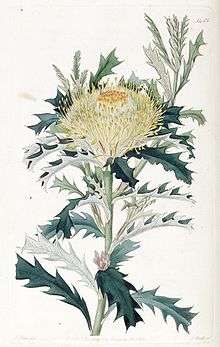Banksia falcata
Banksia falcata, commonly known as prickly dryandra,[2] is a species of prickly, column-shaped shrub that is endemic to Western Australia. It has serrated or pinnatipartite leaves, heads of up to 150 yellow flowers and soft-hairy fruit.
| Prickly dryandra | |
|---|---|
 | |
| Illustration from Edwards's Botanical Register | |
| Scientific classification | |
| Kingdom: | Plantae |
| Clade: | Tracheophytes |
| Clade: | Angiosperms |
| Clade: | Eudicots |
| Order: | Proteales |
| Family: | Proteaceae |
| Genus: | Banksia |
| Subgenus: | Banksia subg. Banksia |
| Series: | Banksia ser. Dryandra |
| Species: | B. falcata |
| Binomial name | |
| Banksia falcata | |
| Synonyms[1] | |
| |
Description
Banksia falcata is a column-shaped shrub that typically grows to a height of 2.3 m (7 ft 7 in) but does not form a lignotuber. It has undulating, serrated to pinnatipartite leaves that are wedge-shaped in outline, 35–80 mm (1.4–3.1 in) long and 15–30 mm (0.59–1.18 in) wide on a petiole 5–12 mm (0.20–0.47 in) long, with between seven and thirteen sharply-pointed teeth on each side. The flowers are borne on a head containing between 110 and 150 flowers in each head. There are linear to narrow lance-shaped involucral bracts 15–20 mm (0.59–0.79 in) long covered with rusty, woolly hairs at the base of the head. The flowers have a bright yellow perianth 30–39 mm (1.2–1.5 in) long and a yellow pistil 32–45 mm (1.3–1.8 in) long. Flowering occurs from September to November or January and the follicles are oval, 6–7 mm (0.24–0.28 in) long and covered with soft hairs.[3][2]
Taxonomy and naming
This banksia was first formally described in 1810 by Robert Brown in the journal Transactions of the Linnean Society of London and given the name Dryandra falcata.[4] In 2007, Austin Mast and Kevin Thiele transferred all the dryandras to the genus Banksia and this species became Banksia falcata.[5][6] The specific epithet (falcata) is a Latin word meaning "falcate" or "shaped like a scythe or sickle".[7]
Distribution and habitat
Banksia falcata grows in kwongan between the Stirling Range and Esperance in the Avon Wheatbelt, Esperance Plains, Jarrah Forest and Mallee biogeographic regions.[3]
References
- "Banksia falcata". Australian Plant Census. Retrieved 25 April 2020.
- "Banksia falcata". FloraBase. Western Australian Government Department of Parks and Wildlife.
- George, Alex S. (1999). Flora of Australia (PDF). 17B. Canberra: Australian Biological Resources Study, Canberra. p. 360. Retrieved 14 April 2020.
- "Dryandra falcata". APNI. Retrieved 25 April 2020.
- "Banksia falcata". APNI. Retrieved 25 April 2020.
- Mast, Austin R.; Thiele, Kevin (2013). "The transfer of Dryandra R.Br. to Banksia L.f. (Proteaceae)". Australian Systematic Botany. 20 (1): 63–71. doi:10.1071/SB06016.
- Francis Aubie Sharr (2019). Western Australian Plant Names and their Meanings. Kardinya, Western Australia: Four Gables Press. p. 197. ISBN 9780958034180.
- Cavanagh, Tony; Pieroni, Margaret (2006). The Dryandras. Melbourne: Australian Plants Society (SGAP Victoria); Perth: Wildflower Society of Western Australia. ISBN 1-876473-54-1.
| Wikisource has original text related to this article: |
| Wikisource has original text related to this article: |
Taxon identifiers | |
|---|---|
| Banksia falcata | |
| Dryandra falcata | |